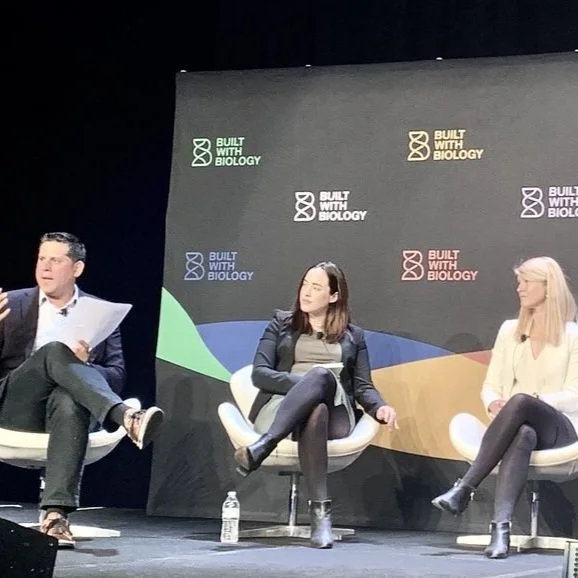An Interview with Seasoned Venture Capitalist Tom Baruch
In 1997, seasoned venture capitalist, Tom Baruch, began shifting his VC practice from materials science, IT, and biotechnology to the then-nascent field of synthetic biology. Since then, he has funded more than 12 synthetic biology companies and has an enviable track record — exiting at 5x to double-digits in as little as 18 months and never losing money.
A champion for innovation, Baruch has mentored startup teams, venture capitalists, and corporate venture and pension funds through his fund, advisory, and family office, Baruch Future Ventures. Baruch not only invests in synthetic biology, but also in energy and renewables, food security, and water and air quality. In addition, Baruch serves as an advisor to Bill Gates' Breakthrough Energy Ventures.
I sat down to talk to Tom before the publication of an article (link) for entrepreneurs that explains how and why to build a profitable $1 billion business over the course of a decade. What follows are excerpts from our conversation.
Karl Schmieder: What is the potential for synthetic biology to impact climate change?
Tom Baruch: Less than 100 years from the discovery of DNA by Watson and Crick in 1953, my vision is the adoption of a circular economy by 2050 based on DNA. My colleagues and I call it "The DNA Economy."
In my opinion, the application of biotechnology to transform manufacturing and impact climate change is one of the most significant opportunities in history. I believe that we must innovate in both biology and chemistry to take coal, oil, and gas off the table. It is our best hope for adequately mitigating climate change and the associated global tensions over carbon-based energy resources.
Synthetic biology provides multiple tools to reduce global greenhouse gas emissions while transforming manufacturing. I believe we'll see synbio disrupt every industry, whether building materials, agriculture and food, chemicals, medicines, water treatment, and environmental engineering.
Schmieder: What is your background?
Baruch: I started at ExxonMobil, where I led early investments in carbon fibers and high-performance composites, flat panel displays, fiber optic sensors, ceramic industrial products, and semiconductor technologies. I pioneered corporate venture capital and founded CMEA Capital, where I personally led 18 IPOs and 8 mergers and acquisitions. I then cofounded Formation 8, a $1 billion venture capital fund.
After that, I started Baruch Future Ventures, a family office where our focus is on investments addressing solutions in climate-sensitive and resource-limited markets. I also work as an advisor to Breakthrough Energy Ventures, one of Bill Gates' family offices focused on energy. I am especially interested in harvesting the unique and defensible startups that emerge from intersections of synthetic biology, artificial intelligence, new mobility, decarbonization, and what I call free electricity.
Schmieder: What drove you to invest in synthetic biology?
Baruch: I was intrigued by the implications of reorganizing DNA sequences to achieve more perfect protein expressions. It offered us the once-in-a-lifetime opportunity to manipulate interesting technology with the potential to make an outsized impact. Accordingly, I invested in Maxygen, one of the original synthetic biology startups, back in 1997. Maxygen was founded by legendary Silicon Valley entrepreneur Alex Zaffaroni, a San Francisco Bay Area scientist. He founded the company to commercialize research on gene shuffling or directed evolution, a technology from Frances Arnold's lab at Caltech. Arnold went on to win a Nobel Prize for her work in 2019. Maxygen went public on NASDAQ in 1999 as a billion-dollar unicorn.
Codexis was the second synthetic biology company I invested in. My firm CMEA Ventures was a founding investor in Codexis in 2002, and I served as Chairman of Codexis for 15 years. Today, Codexis is an example of a publicly traded synthetic biology company that has consistently met or exceeded analyst forecasts for profitability in almost every quarter for the past five years and has firmly crossed over into unicorn status. Since then, I've gone on to fund another ten synthetic biology companies.
Schmieder: You recently wrote a paper that gives the steps for building a $1 billion company in ten years. Why $1 billion? And why ten years? Isn’t 10 years a long time?
Baruch: It sounds like a high number, but a billion dollars isn't what it used to be, and most venture capitalists will only invest in companies that provide billion-dollar exits.
Ten years isn't really that long. But, unfortunately, humans have a hard time understanding exponentials, and when it takes 20 years to implement change, our brains do a poor job at understanding the effort needed.
Generally, a startup isn't going to scale and reach that $1 billion valuation without an infusion of cash. That cash will probably come from venture capitalists with that 8-to-12-year life fund. That means VCs are forced to enter and exit from all investments during that time.
At Baruch Future Ventures, we've crunched the numbers and shown that investing in companies that will return money in 10 years instead of 20 triples the rate of return.
Focusing on building a billion-dollar unicorn in ten years is a form of time compression that allows startups to exercise the same compounding forces inherent in exponential technologies while also delivering returns to investors.
Schmieder: What are some of the steps to building a $1 billion company?
Baruch: Building a synthetic biology company - or any science-based business - will be challenging. In the beginning, the most important organizing principle is problem orientation. It can't be about the technology because technology has mostly become a commodity. So, you have to focus on solving a problem for a customer.
In the beginning, the company is a business searching for a business model. We suggest working with a business model canvas and executing relentlessly against it until the startup can shift to execution mode. The canvas is a tool for execution and for defining that unique value proposition - the reason why customers will pay for your product.
I believe it's possible to shrink time by thinking big but starting small. This is what Tesla did. In the mid-2000s, Elon Musk stated Tesla's long-term goal was to create affordable mass-market electric vehicles. Tesla started delivering premium sports cars, which were actually retrofitted Lotus sports cars. Those were aimed at early adopters. Then Telsa moved into mainstream vehicles. Musk revealed this strategy in a famous 2006 blog post.
I like for entrepreneurs to follow the Goals Objectives Strategies and Tactics framework. GOST helps entrepreneurs create the mindset and behaviors necessary to pivot when disruption hits. GOST is the basic foundation of any successful business. Other critical elements of building a billion-dollar company are focusing relentlessly on applications development and on excellence in every dimension while executing against milestones.
Schmieder: Where does the business model fit into this?
Baruch: I say it's the business model stupid. Every successful company owes its success to its business model. The business model is the engine of transformation.
Innovating business models have long been the domain of disruptive startups looking to compete against established players and allow a startup to change the rules of the game, create new markets, and reshape entire industries. Developing an effective business model requires customer focus. When you're focused on customers, you can scale sales more quickly. Scaling sales is as important as scaling manufacturing. You don't want to get stuck focusing on technology development.
Schmieder: Can you provide an example of a synthetic biology that has innovated its business model?
Baruch: Sure. Calysta creates sustainable protein for food and feed ingredients by fermenting natural gas with naturally occurring bacteria. Its proprietary gas fermentation allows Calysta to focus on the shrimp farming industry, offering a level of nutritional benefits that never existed before In addition, Calysta's approach to protein production offers a level of transparency that is important in an industry that is still rampant with slave labor. Early on, Calysta realized that its optimal business model was joint venture sales to a consortium of customers. This business model resonated with the marketplace and resulted in a solid partnership with the global agriculture and food company Adisseo and investments from BP, Temask, and Aquaspark.
Schmieder: As an investor, how do you interact with the companies you work with?
Baruch: I usually interact with the founders every 4-6 weeks over the first couple of years. I like mentoring the people who are responsible for making things happen.
Schmieder: Any closing thoughts?
Baruch: I'm an optimist and am optimistic. I have overwhelming evidence that entrepreneurs and purposeful innovation are the superordinate force that will make a meaningful contribution to climate change.
Learn more about Baruch Future Ventures by visiting their website. Follow Tom on LinkedIn.
If you enjoyed this post, here are some others you may enjoy.










